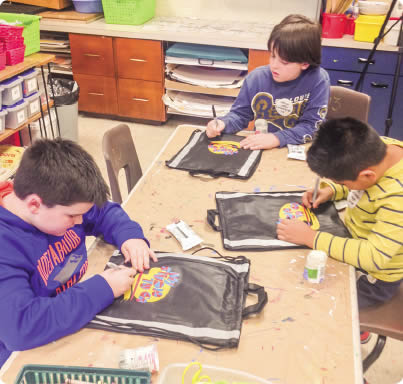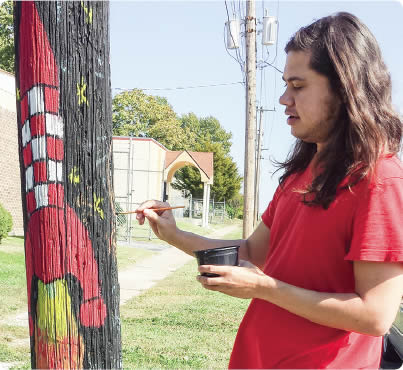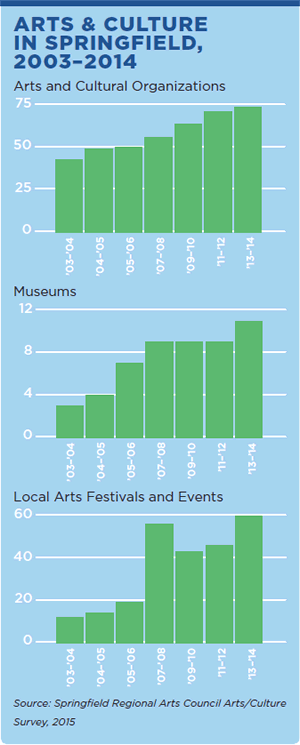ARTS & CULTURE
Thanks to the 11 colleges and universities that call Springfield home, the city sits on a significant talent pipeline that consists of an educated, diverse workforce. However, U.S. Census Bureau data shows a majority of these college students are moving out of Springfield after graduation. Community leaders and college professors have looked into what motivates students to stay in the area, and the majority of them cite the community as the leading factor for retention. Millennials crave strong ties to the community and diverse options—making the arts one of the key players in retention.
With a multitude of arts programs and organizations, numerous festivals, events and educational activities for all, the arts community is arguably one of the best in the region. Encouraging placemaking activities and development of the creative industries leads to more retained graduates. This results in a vibrant and dynamic community, a key selling point to businesses and individuals looking to relocate to Springfield.BLUE RIBBONS
Arts Education Efforts
Although the John F. Kennedy Center's Ensuring the Arts for Any Given Child program was mentioned in the 2011 and 2013 Community Focus Reports (CFRs), significant progress has been made in the past two years. In 2009, Springfield was named as the program's second city in the nation to provide equitable access in the arts for every child in the Springfield Public School (SPS) district. Before the initiative began in 2009, every SPS student in grades 2-5 participated in an arts experience provided by a community arts organization. The following programs have been added since 2013 to address arts equity and access issues:
- "My Studio to Go," a visual arts pilot program providing monthly art supplies for all students to take home in grades 2 and 6;
- An annual live opera performance provided by Springfield Regional Opera for students in kindergarten and first grade; and
- An annual performing arts experience provided by Missouri State University for students in eighth grade.

Outside of the schools, arts and cultural organizations continue to focus their efforts in providing access to the arts for families. Springfield Little Theatre's education program has reached an all-time high of 1,800 participants. The Springfield Art Museum released its new branding and strategic plan that includes a focus on promoting family learning through the visual arts. "Growing Up in the Arts," a collaborative program of the Springfield Regional Arts Council (SRAC), continues to provide weekly arts education instruction year-round to students ages 3-13 from the Lighthouse Child & Family Development Center (serving ages birth to 5) and the Springfield Community Center (serving ages 6-13).
Collaboration & Partnerships
Since the 2005 CFR, collaboration has been a significant factor in shaping the success of the arts and culture community. These relationships enable organizations to share resources and enhance educational experiences, producing substantial programming to the benefit of the area. Since 2013, the following partnerships have taken place:
- The Springfield-Greene County Park Board deepened its collaborative connection to the arts by funding the SRAC Executive Director position and developing arts-enriched programming throughout the system.
- Drury University Arts Administration students conducted community impact evaluations for the ideaXfactory and the Springfield Art Museum's public programs in April 2014.
- Moxie Cinema started a new initiative to build community awareness around specific issues being addressed by local nonprofits and universities.
- The Brick City Design Studio, a fully functioning, fee-based graphic design studio embedded in the curriculum of Missouri State University's Art + Design Department and staffed with senior-level students, takes on local clients to complete branding campaigns, web-design projects, and other design needs.
- Studio 55, an association of artists and patrons dedicated to making opportunities for artists in their later years, partnered to host exhibits and classes at the Springfield-Greene County Botanical Center and the Library Center.
- The Springfield-Greene County Library District partnered with the SRAC to host several arts projects, including the Mantel Collection at Midtown Carnegie Branch Library. The organizations also hosted a Flash Fiction Contest with artists interpreting the stories live at Artsfest.
- Students from Ozarks Technical Community College's Department of Fine Arts and Humanities Acting Fundamentals class wrote original plays to address bullying issues and performed for SPS fifth graders in partnership with the district's Office of Diversity and Inclusion.
Public Art
As included in the 2013 CFR, Springfield has seen a rise in interest regarding public art. Although the City Council has yet to take up a "percent for public art" initiative, many programs have emerged in the past two years.
Random installations of public art continue to emerge in the form of temporary installments from Drury University's Art of Space and the ideaXfactory. The "yarn bombing" trend has appeared in Springfield and has been prominently featured in local media as numerous trees and lampposts have been given a colorful yarn makeover downtown.

Recently, the Moon City Creative District has made gains in rejuvenating the identity of the Woodland Heights Neighborhood. Rezoning policies are now in place to turn blighted industrial, commercial and residential buildings and land into artist live/work spaces. Monthly events like the Moon City Jam draw musicians from around the area to Big Momma's Coffee and Espresso Bar for a night of music and community. Utility light poles in the District now boast mini-murals painted by local artists and a mural is planned for an overpass within the district as well.
Public Works is proud of our collaborative relationship with the arts sector, which has resulted in unique and innovative additions to our community such as sidewalk poetry, public areas to display art and support for The Creamery and ideaXfactory. We look forward to the things we will accomplish in the future by working together to enhance the quality of life in Springfield.DAN SMITH
DIRECTOR OF PUBLIC WORKS, CITY OF SPRINGFIELD
Farmers Park, a multi-use private development designed for low-impact and long-term sustainability, is working to grow the local creative community by providing a venue for local and regional artists, in the same way the development provides a venue for local farmers and vendors. In 2014, Farmers Park and the SRAC partnered on the Farmers Park Arts Project to select up to seven artists, including conceptual artist Matthew Mazzotta, for permanent art installations.
The Springfield Sculpture Walk, mentioned in the 2013 CFR as a possible initiative, is now a formal organization under the SRAC's umbrella. The unveiling of the program is set to occur in downtown Springfield in spring 2016.
RED FLAGS
Capacity Building
Springfield arts organizations continue to provide quality programs for the community, but only by sacrificing other areas of capacity in order to do so. Due to the lack of private and public funding support for operational expenses, arts and culture organizations do not have sufficient capital to:
- Update and maintain their administrative systems including critical hardware and software needed to do business efficiently and effectively.
- Compete in the market for salaries and benefits to attract and retain key creative talent.
- Repair and maintain aging facilities.
Evan Bennett, executive director of the Springfield Ballet, said in the 2015 Arts and Culture Survey: "Each one of our organizations is growing more and more dependent on software for donor records and alumni tracking and we are crippled by the cost of the upkeep of these systems." In addition to current program funding opportunities by area funders and donors, more opportunities for day-to-day operational funding are needed to address the aforementioned capacity issues. Addressing these capacity issues is critical to ensure our arts and culture organizations meet market and technology demands.
Timely Cultural Data
Timely data on audiences and programming is key to the development of any arts organization, but collecting it takes considerable financial and staff resources from already over-taxed organizations. Area arts organizations do not have resources to devote to collecting detailed data and analysis.
Even the SRAC, the umbrella organization for the community's arts programs and organizations, is unable to devote the time or financial resources to hire consultants to mine the data for the community. Some larger organizations, such as Springfield Little Theatre, are able to gather demographic information from their patrons, but a robust and cohesive look at Springfield's arts ecosystem needs to be compiled in order for administrators to understand their current and potential audiences' behaviors.
Lack of Sustainable Funding
Sustainable funding has been an ongoing issue for the arts and culture sector since the 2004 CFR. Little progress has been made to address the significant need for consistent funding. Ongoing fluctuations and the volatile nature of state and federal funding since 2009 have required arts and culture leaders to return to overburdened donors for operating and programming support every year. According to the 2015 Arts and Culture survey, 58 percent of respondents stated that the most significant barrier to growth is access to financial resources.
As a key component in economic and workforce development, investing in arts and culture is critical. According to Americans for the Arts' Arts and Economic Prosperity III study, Missouri nonprofit arts organizations generate $1.1 billion in economic impact activity annually. Leveraging this impact with sustainable public support for the arts builds a stable environment for creativity and communities to thrive. Some strides have been made to remedy this ongoing threat, including the Hotel/Motel Tax Reallocation grant funds for capital projects and the Springfield Arts Collaborative endowment-building campaign. State appropriations for the arts through the Missouri Arts Council have increased nominally since 2013 to $4.8 million, but this amount is only roughly 25 percent of what should be allocated for the arts according to state statute. Consistent public investment is needed to truly address the issues of capacity building, data collection and creative workforce development.

